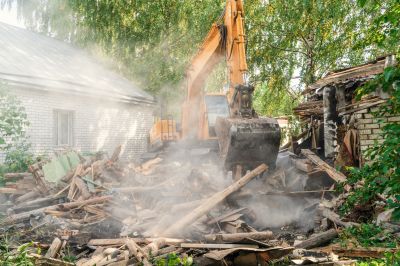Favorite Products for Demolition Service Contractors
Browse trusted equipment options that meet the demands of professional demolition contractors for various project sizes.
 In the realm of demolition services, selecting the right tools and equipment is essential for efficiency and safety. For professionals operating in Raleigh, NC, understanding the variety of available products can help streamline projects and ensure effective results. Demolition tasks often require specialized gear ranging from hand tools to heavy machinery, each designed to handle different materials and scales of work. Whether tearing down structures, removing concrete, or dismantling interiors, having the appropriate equipment is vital.
In the realm of demolition services, selecting the right tools and equipment is essential for efficiency and safety. For professionals operating in Raleigh, NC, understanding the variety of available products can help streamline projects and ensure effective results. Demolition tasks often require specialized gear ranging from hand tools to heavy machinery, each designed to handle different materials and scales of work. Whether tearing down structures, removing concrete, or dismantling interiors, having the appropriate equipment is vital.
Top Overall Option
Heavy-Duty Demolition Hammer
A versatile and powerful demolition hammer can handle a wide range of tasks, from breaking concrete to removing tiles. Designed for durability and ease of use, this tool often features adjustable settings and ergonomic grips to enhance safety and comfort during extended use. Its robust construction ensures it can withstand demanding demolition environments, making it a valuable addition to any professional toolkit in Raleigh, NC.
Types of Products For Demolition Service
Rotary Hammers
Ideal for drilling into tough materials and light chipping, rotary hammers are versatile tools suitable for various demolition tasks.
Jackhammers
Hand-held jackhammers are commonly used for breaking up concrete, asphalt, and other hard surfaces in demolition projects.
Demolition Saws
Power saws designed for cutting through masonry, metal, and wood are essential for precise demolition cuts.
Concrete Crushers
Heavy machinery attachments or standalone crushers are used to break down large concrete structures efficiently.
Hydraulic Breakers
Hydraulic tools attach to excavators for large-scale demolition and heavy-duty material breaking.
Pry Bars and Wrecking Bars
Manual tools for prying apart structures, removing nails, and dismantling components during demolition.
Safety Gear
Protective helmets, gloves, goggles, and respiratory masks are vital for ensuring safety during demolition activities.
Dust Suppression Equipment
Tools and systems designed to minimize dust during demolition, improving site safety and cleanliness.
Scaffolding and Lifts
Equipment to access elevated areas safely and efficiently during demolition work.
Material Removal Containers
Skip bins and dumpsters for collecting and transporting debris on-site.
Air Compressors
Provide power for pneumatic tools used in various demolition tasks.
Hydraulic Shears
Attach to excavators for cutting through steel and reinforced concrete.
Wire and Cable Cutters
Tools for safely cutting electrical wiring and cables during dismantling.
Vibratory Plate Compactors
Used for preparing surfaces after demolition or for ground work.
Laser Distance Measurers
Precision tools for measuring spaces and ensuring accurate demolition plans.
Portable Generators
Provide power to tools and equipment in remote or outdoor demolition sites.
Popular Choices
Widely used for small to medium demolition tasks, offering portability and ease of use.
Effective for removing nails quickly during dismantling operations.
Provide mobility and convenience for drilling and chipping in various locations.
Popular for precise cuts in concrete and masonry work.
Attach to excavators for large-scale demolition projects involving concrete and stone.
Essential safety gear that offers protection during high-impact demolition work.
Help control dust and debris, maintaining a cleaner work environment.
Supply hydraulic pressure for various attachments and tools on-site.
Popular manual tools for prying and dismantling structures.
Commonly used post-demolition for ground preparation.
Laser levels and distance meters for accurate planning and execution.
Ensure visibility in poorly lit demolition sites.
Facilitate safe and efficient debris removal from higher levels.
Popular for cutting through metal structures and rebar.
Provide safe access to elevated work areas.
Help secure demolition zones and control access.
Reliable power sources for various tools in remote sites.
Efficiently remove nails from salvaged materials.
Durability and safety features are key considerations when choosing demolition products. High-quality tools can withstand rigorous use and provide reliable performance over time. Additionally, safety gear such as protective gloves, goggles, and helmets should always accompany demolition equipment to minimize risks. Proper training and adherence to safety standards are equally important to prevent accidents during demolition activities.
For those managing demolition projects in Raleigh, NC, it’s also helpful to consider the compatibility of tools with specific tasks. Some jobs may require lightweight equipment for precision work, while others demand heavy-duty machinery capable of handling substantial loads. Versatile equipment options can often serve multiple purposes, making them cost-effective choices for contractors and DIY enthusiasts alike. Investing in reliable, well-designed products can contribute significantly to the overall success of demolition operations.
Key Buying Considerations
- Project scale and scope to determine the appropriate size and power of equipment.
- Material types involved, such as concrete, steel, or wood, which influence tool selection.
- Frequency of use to assess durability and investment value in equipment.
- Safety features and certifications to ensure compliance with safety standards.
- Portability and weight of tools for ease of transport and maneuverability.
- Power source availability, including electric, pneumatic, or hydraulic options.
- Ease of maintenance and availability of replacement parts.
- Compatibility with existing tools and machinery used on-site.
- Budget constraints balanced with quality and performance requirements.
- Environmental conditions of the demolition site, such as confined spaces or outdoor exposure.
- Operator skill level and training requirements for specific equipment.
- Site accessibility and space constraints that may impact equipment choice.
- Noise levels and vibration emissions, especially for urban or sensitive areas.
- Regulatory compliance and adherence to local safety codes.
- Availability of rental options versus outright purchase, depending on project duration.
